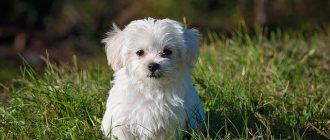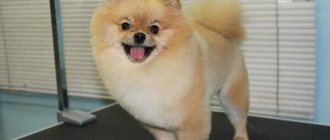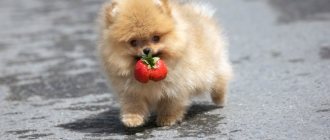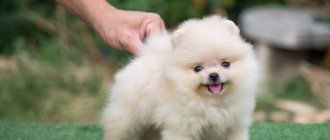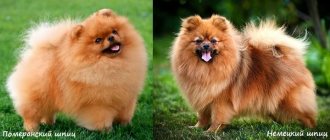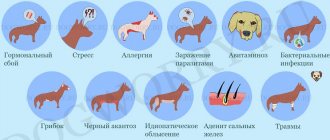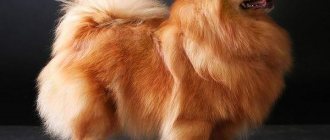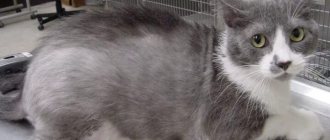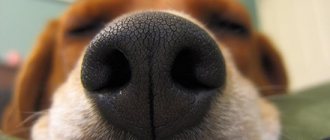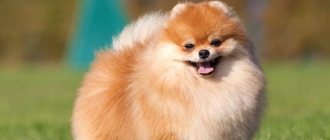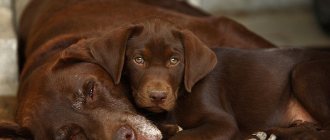The charm of the Pomeranian Spitz largely depends on the condition of its shiny coat. The long, thick coat gives the dog a beautiful, cheerful appearance.
Intensive loss of hairs remaining everywhere indicates problems in the pet’s body. Bald patches and unpleasantly translucent skin make the Pomeranian unkempt and deprive him of most of his natural charm, and may also indicate improper maintenance of the dog. In order for the bald Spitz to once again boast a luxurious woolen robe, it is necessary to understand the nature of the problem that has arisen.
Causes of baldness in Spitz dogs
Pomeranians typically have long, beautiful outer hair and a very thick undercoat. When choosing a puppy, future owners try to give preference to the most charming baby, but they are not always sufficiently aware of the necessary care for the fur coat. If you do not prevent the appearance of hair mats in a timely manner, your pet's hair will be in danger. It should be remembered that hair loss does not always mean serious problems. Perhaps the Spitz is simply shedding, which is reflected in its “fluffiness”.
The reasons why a Pomeranian is not fluffy may lie in poor diet, allergies to food and treats, or hormonal imbalances. In these cases, pronounced baldness may appear. If problems with the dog's coat appeared at a fairly early age, there may be a genetic disorder, which is sometimes found in Spitz puppies.
The main causes of Spitz alopecia
Baldness in Spitz dogs is often caused by poor dog husbandry, but can be hormonal or caused by environmental factors. Owners of every sixth Spitz face the problem of baldness. Research on this topic has not yet proven genetic transmission of the disease, and the exact causes of alopecia in Spitz have not been established.
Alopecia can occur in Spitz dogs that have not shed their puppy coat into adult fur and undercoat (most commonly affecting males), or in dogs with hypothyroidism (low thyroid hormone levels) or hyperadrenocorticism (increased cortisol levels, also called Cushing's syndrome).
Poor nutrition
The formation and maintenance of the coat of a Spitz accounts for about 60% of the nutrients obtained from food. If the recommendations of breeders and veterinarians about the diet are not followed, the load on the pancreas, liver and kidneys, and gastrointestinal tract increases. Metabolism is disrupted, and health and hair problems begin. Spitz baldness can be caused by feeding unbalanced, spicy, fatty, fried, salty, sweet foods, baked goods, and sweets.
Improper care
Spitz wool requires careful, high-quality, constant attention. If you rarely wash your dog, do not use high-quality shampoo and conditioner, and allow tangles to appear, then the hair follicles weaken, it becomes difficult to change the coat, and bald spots appear.
Read 10 symptoms of allergies in dogs and effective ways to treat the disease
Walks
Spitz dogs, especially males, who do not get enough physical exercise in the fresh air lose their hair more often than their actively walking counterparts. The Spitz does not require clothing, regardless of the time of year and the temperature outside. Cold air stimulates the active growth of new hair and undercoat. It is recommended to walk an adult Spitz at least 1 hour a day.
Also possible causes of alopecia are hormonal imbalances, stress, infections, and parasites.
Shedding
Pomeranians, like other dog breeds, are prone to shedding. The fact is that each hair, having gone through its life cycle, dies, leaving room for new hair. Pomeranians have a long and intense period of hair loss. A dog can shed heavily, losing about half the volume of its coat. There are several types of shedding - seasonal, age-related and hormonal.
Seasonal
Hair begins to fall out under the influence of the hormone melatonin, released in the pituitary gland as a reaction to changing climatic conditions. Such molting occurs in the off-season - in spring and autumn. By the warm season, the orange sheds its warm undercoat, and in the fall it loses its long hairs so that there is more space for a downy coat. If the dog is indoors and rarely goes outside, shedding occurs gradually throughout the year.
Age
At about four months of age, Pomeranian puppies experience their first molt. Baby fluff is replaced by coarse wool, and the color of the pet may change. First, the fluff disappears on the dog’s face, then on the body, and at the very end the collar and panties of the hind legs peel off. At the same time, molting can occur gradually or abruptly.
In the second case, especially with the rapid growth of the animal , the fluff is shed sharply and the new appearance can shock the owner. The second stage of coat change occurs when the dog is one year old, and can become a smooth continuation of the puppy moult. The undercoat that has already appeared falls off within three months, giving way to coarse hair. The dog takes on the familiar appearance of a classic orange at the age of two.
Hormonal
The female half of Pomeranians are prone to intense hair loss during estrus. And in the event of childbirth, noticeable bald patches may appear on the dog, or even almost complete baldness may occur. During this period, the pet must be fully fed, ensuring the correct set of vitamins and microelements in the diet.
Hair loss can be caused by hormonal imbalance. You need to pay attention to the following possible problems:
- bald patches near the female genitals may indicate excess estrogen formed in the body;
- a castrated female can rarely boast of a healthy coat; a lack of estrogen makes the hair thin and inhibits its growth;
- severe sudden hair loss can be caused by large amounts of cortisol;
- if the thyroid gland is malfunctioning, the fur becomes brittle and falls out on the chest and back of the animal;
Other reasons
Hair loss without signs of skin inflammation in Spitz dogs is called alopecia X. There is no clear answer to why a dog develops this disease.
Parasites
Various worms that have found refuge in the dog’s digestive system release harmful substances that provoke permanent poisoning in the animal. In addition, uninvited guests absorb nutrients, creating their deficiency in the Spitz's body.
Mites living on the surface of the skin or a fungal infection usually provoke itching and, as a result, wounds and scratching. Hair falls out. Bald spots may appear, in some cases covered with crust or scales.
Alopecia X
Alopecia X is manifested by total baldness of the Spitz, in which hair remains only on the head and paws. It appears either in six-month-old puppies, which for some reason did not begin to shed on time, or in adult dogs aged 3-4 years. An excessively short haircut of the dog can provoke an incipient disease.
Symptoms
The first symptoms of alopecia X in animals include dry and brittle hair. It feels like the dog made a bad trip to the hairdresser. Later, hair and fluff continue to appear in clumps, and bald spots appear. If such signs appear, you should visit a veterinarian and rule out serious diseases.
Treatment
Treatment of alopecia X is best done after consulting a doctor and conducting the necessary research. Even a simple urine test can clarify the situation. You can start treatment by using antifungal and medicated shampoos, which will prevent your Spitz from developing skin problems if the immune system is weakened. A course of vitamins and probiotics that improve intestinal function will not be superfluous. If baldness is caused by a malfunction of the thyroid gland, you will have to resort to hormonal treatment. Veterinarians often suggest resorting to castration.
When to go to the doctor
If hair loss becomes pronounced, you should consult a veterinarian-dermatologist. The following signs indicate developing alopecia X disease:
- at one year of age, timely shedding has not occurred, but puppy fluff is still present;
- the appearance and condition of the coat indicate problems;
- the appearance of itching and bald spots, ulcers and scratching on the skin;
- the eyes turned red, the fur around them thinned;
- In bald spots, the skin darkens.
If your Spitz is going bald, the first thing to do is take urine and blood tests. Based on their results, the dog’s health status will become clear.
Prevention
Constantly following the recommendations of veterinarians and Spitz breeders helps owners avoid alopecia in their dogs.
- Quality food. It is necessary to feed your Spitz with premium, super-premium commercial ready-made food, or a fully balanced diet of fresh products prepared independently. When feeding natural food, it is necessary to take into account all the dog’s nutritional needs, do not forget about fermented milk products, fresh vegetables and fruits. A Spitz owner can get nutritional recommendations from their breeder or veterinarian.
- Inclusion in the diet of supplements, vitamin and mineral complexes aimed at strengthening the immune system and improving the quality of the coat. Olive oil, omega-3 polyunsaturated fatty acids, fish oil, vitamin E - improve coat and skin, accelerate the shedding process and activate new hair growth. Rose hips, berries, sea fish - restore and support immunity. Pet stores offer ready-made tablet or liquid vitamin complexes for dogs, among which each owner can choose the optimal one for his dog.
- Your Spitz should be washed weekly using moisturizing shampoos and conditioners. Be sure to dry your dog completely and thoroughly to avoid getting the coat wet - this can cause eczema and dermatitis.
- You need to brush your Spitz every day with a massage brush. It is important to comb the wool completely, from the very roots, without leaving tangles. This will accelerate the loss of dead hair and awaken the follicles for active growth of the fur coat. Experienced breeders recommend moistening the Spitz's coat with a moisturizing conditioner diluted with water in a ratio of 1:10 before combing. Particular attention should be paid to combing during the period of shedding - the maximum loss of dead hair. In males, shedding occurs twice a year, in spring and autumn, in females, plus the off-season - before, during or after estrus, pregnancy, the period of feeding puppies
- Timely deworming and vaccination. If the Spitz's body is weakened by parasites, the dog's immunity and overall body resistance are reduced, which means the risk of baldness increases and treatment in this situation will be longer and more complex. Timely vaccination allows you to protect your animal from common infections that are dangerous in themselves and reduce the body’s defenses.
Read What is the normal temperature in dogs and newborn puppies
Prevention of baldness
Caring for a Spitz's coat is somewhat more difficult than in the case of other breeds that do not have as much hair. Caring for your fur coat must be thorough. Many owners forget about daily combing, which leads to the formation of tangles.
Puppies need to be brushed with a soft brush, while metal combs are better for adults. You need to pay attention to feeding your pet. The content of microelements and vitamins must be balanced. Dog nutrition includes food specifically designed for furry breeds.
Alopecia after haircut
There are situations when alopecia occurs after cutting a Spitz with a clipper. Researchers explain this by saying that in this case the hair is cut off right to the root. Because of this, a lot of “stumps” remain, which the pet cannot get rid of for a long time.
Spitz often begin to go bald regardless of the molting process or continue after it. This phenomenon can lead to complete baldness of the pet, darkening of bare skin areas. The exact causes of these symptoms are unknown, making treatment difficult. If your dog begins to actively go bald after shedding or at unusual times, you should immediately contact a veterinarian.
